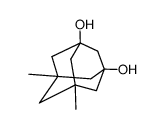


We are 1,3-dihydroxy-5,7-dimethyladamantane CAS:10347-01-0 manufacturer and supplier in China, Pls send inquiry of to info@nbinno.com of visit www.nbinno.com our official website should you have any interests

|
Product name: |
1,3-dihydroxy-5,7-dimethyladamantane |
|
CAS NO.: |
10347-01-0 |
|
Structure: |
|
|
Synonyms: |
1,3-DIMETHYLADAMANTANE-5,7-DIOL;AKOS BC-0469;5,7-DIMETHYL-1,3-ADAMANTANEDIOL;1,3-dihydroxy-5,7-dimethyladamantane |
|
MF: |
C12H20O2 |
|
MW: |
196.29 |
|
Melting point : |
|
|
Chemical Properties: |
White powder |
|
Purity |
98% |
|
Capacity: |
500KG /month |
|
Package |
In paper drums /Fluoride drums /iron drums /plastic drums/IBC Tank ,etc. |
|
Shipment method : |
By Sea ,Air ,Courier door to door ,etc. |
|
Storeage: |
Under room temperature ,keep away from direct sun light |
|
Loading Port : |
China any port ,Beijing ,Shanghai ,Hongkong |
|
Transportation condition: |
Shipped as non- dangerous chemicals |
|
Application: |
Analog Semiconductors, Light-Emitting Diodes LEDs, Solar Photovoltaics PV |
Introduction
A photoresist is a light-sensitive material used in several processes, such as photolithography and photoengraving, to form a patterned coating on a surface. This process is crucial in the electronic industry.The process begins by coating a substrate with a light-sensitive organic material. A patterned mask is then applied to the surface to block light, so that only unmasked regions of the material will be exposed to light. A solvent, called a developer, is then applied to the surface.
In the case of a positive photoresist, the photo-sensitive material is degraded by light and the developer will dissolve away the regions that were exposed to light, leaving behind a coating where the mask was placed.
In the case of a negative photoresist, the photosensitive material is strengthened (either polymerized or cross-linked) by light, and the developer will dissolve away only the regions that were not exposed to light, leaving behind a coating in areas where the mask was not placed.
Based on the chemical structure of photoresists, they can be classified into three types: Photopolymeric, photodecomposing, photocrosslinking photoresist.
Photopolymeric photoresist is a type of photoresist, usually allyl monomer, which could generate free radical when exposed to light, then initiates the photopolymerization of monomer to produce a polymer. Photopolymeric photoresists are usually used for negative photoresist, e.g. methyl methacrylate.
Photopolymerization of methyl methacrylate monomers under UV that resulting into polymer
Photodecomposing photoresist is a type of photoresist that generates hydrophilic products under light. Photodecomposing photoresists are usually used for positive photoresist.
Photolysis of a dizaonaphthoquinone that leads to a much more polar environment, which allows aqueous base to dissolve a Bakelite-type polymer.
Photocrosslinking photoresist is a type of photoresist, which could crosslink chain by chain when exposed to light, to generate an insoluble network. Photocrosslinking photoresist are usually used for negative photoresist.
The Related Products: CAS NO.10347-01-0 1,3-dihydroxy-5,7-dimethyladamantane
1. 5-Hydroxy-2,6-norbornane carbolactone CAS NO.92343-46-9
2. 3-isopropyl-1-adamantanecarboxylic acid CAS NO.26847-09-6
3. 3-amino-1-adamantanol CAS NO.702-82-9
Related Products:y not counted manufacturer | Butane, 2-methoxy-3-methyl-1,1-bis(methylthio)- supplier | 2-(4-(4-methoxyphenyl)piperazin-1-yl)ethan-1-amine trihydrochloride producer.
| Product Name | |
|---|---|
| DL-10-Camphorsulfonic Acid Cas:5872-08-2 | View Details |
| gelatin Cas:9000-70-8 | View Details |
| Dimethyl sulfide | View Details |